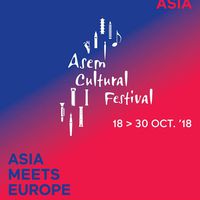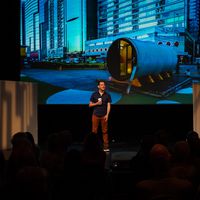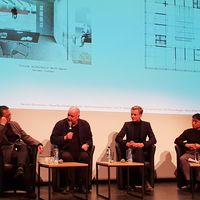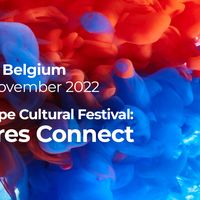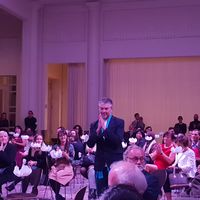How Europe Meets Asia | Interview w/ Paul Dujardin

As the ASEM Cultural Festival kicks off this week, Ambassador Karsten WARNECKE, Executive Director, Asia-Europe Foundation (ASEF), poses questions on the Centre for Fine Arts-Brussels (BOZAR), Europe and cultural co-operation to Paul DUJARDIN, CEO & Artistic Director of BOZAR.
An advocate for culture in Europe, DUJARDIN has been steering BOZAR since 2002. The Centre is an interdisciplinary cultural venue that enables partnerships between artists, scientists, entrepreneurs, and politicians from Europe and the rest of the world.
Asia and Europe form indeed a single geographic whole, unseparated by any seas. Yet, we still have to connect the minds and souls of many of our citizens, and let our shared values and ideas grow.
Ambassador Karsten WARNECKE: What is the most interesting change you have observed in recent times in the way Europe meets Asia, and Asia meets Europe?
Paul DUJARDIN: The Centre for Fine Arts-Brussels (BOZAR) has collaborated extensively with Asia through an ambitious cultural programming in a variety of disciplines (exhibition, music, literature, cinema) and has contributed to open up new critical imaginaries, to build bridges between communities through permanent intercultural exchanges and debates, and to offer new perspectives.
Related to this, I would like to share with you one of the most memorable experiences I was lucky to be part of. I am referring to the exhibition A Passage to Asia: 25 centuries of exchange between Asia and Europe which we organized in 2010 during the 8th ASEM Summit in Brussels. The project was a collaboration between BOZAR and ASEMUS (Asia-Europe Museum Network) and a unique example of the importance of international cultural relations. It is often quoted as a major exhibition about Asian cultural heritage, which contributed to go beyond pre-conceived ideas, thus improving our mutual understanding.
Asia and Europe form indeed a single geographic whole, unseparated by any seas. Yet, we still have to connect the minds and souls of many of our citizens, and let our shared values and ideas grow.
Today, in the digital age, driven by connectivity and quick responses, the concept of cultural diplomacy has changed dramatically. Our world is changing rapidly and this concerns both the bigger picture (the geopolitical dynamics) and the daily life on the ground (our bottom-up perspective). This is why I sometimes prefer the words “Cultural Relations” to “Cultural diplomacy”. “Relations” are indeed reciprocal and highlight the reality of today. It is all about inter-relations.
Mutual understanding, that is the urgency of today: how to combat stereotypes, ignorance, populism and enhance intercultural dialogue across borders?
Projects like A Passage to Asia and today, ASEM Cultural Festival are part of the answer by creating understanding, knowledge and hence help to build up slowly but surely a common vision of the world.
Amb WARNECKE: How has BOZAR’s role as a home for cultural dialogue – both in the Belgian capital and the symbolic capital of the EU – changed in the last decade?
DUJARDIN: Let me answer with the first sentence of our cultural mission we formulated five years ago: ‘As the oldest and largest arts centre in Belgium, BOZAR is intended to be the model for the European cultural centre of the 21st century.’ Wanting to be a model is very ambitious, it sounds maybe a bit pretentious. One cannot copy and paste a cultural house from one city to another. A cultural centre that wants to link to a European reality, and to a European public has to start from the local context and from there on make connections to your direct neighbours, the city and the citizens. Brussels gives a lot of symbolic capital to BOZAR but also a huge responsibility. We started an active dialogue with the European Commission and other EU institutions, including bilateral contacts with the Member States but also non-members who belong to the much larger club of the Council of Europe.
Brussels is a different reality than other art houses across Europe. We do co-organise exhibitions and festivals on the European heritage, like now with the exhibition Beyond Klimt - New Horizons in Central Europe 1914-1938 we have set up with the Belvedere Museum in Vienna during the Austrian Presidency. We also stimulate living artists to engage in the quest for European narratives and imagery. And we feel responsible to advocate for culture at EU level. As a European cultural institution, it is our responsibility to make cultural heritage and the living artists part of the European project and constantly show that culture is the true glue for a European citizenship. Like the writer and scientist Umberto said: “The capital of the European Union should become a foyer culturel, a centre for the confrontation of diversities.” So, we have turned BOZAR into a European Agora for encounters between people from different sectors involving not only the fine arts but also debates on the big issues of today, educational programmes to engage with citizens, and projects on the crossroads between the arts, sciences and technology.

Ambassador Karsten WARNECKE, Executive Director, ASEF (L) and Mr Paul DUJARDIN, CEO & Artistic Director, BOZAR (R)
Amb WARNECKE: Are public institutions changing fast enough for the changes in our society? What has been BOZAR’s journey in this regard? Are public-private partnerships the future?
DUJARDIN: In the 21st century Europe’s cultural institutions like BOZAR are facing rapid transformations. These transformations are the result of a re-examination of the role of modern public institutions in today’s society and the changing user demands. Cultural institutions are re-defining their relationship with society. This at a time when global economic, ecological and social challenges have increased the need for innovative solutions resulting from interactions between different horizons and disciplines.
BOZAR is a public institution, originally built by civil society after the First World War with the ambition to bring cultures together and avoid new wars. Located in the heart of Brussels, BOZAR is aware of its role as a central, public space within the city, and its potential for pragmatic engagement of people with democracy. As such, BOZAR closely monitors these societal changes and takes them into account when developing our cultural programme. In our view, a cultural project is a social project, a community project. Culture is an essential pillar of social cohesion. Culture helps to build communities.
As society changes, so must the public institutions that serve them, that is, in essence, their role. Today cultural institutions feel obliged to justify their right to exist by responding to a particular role in society and to respond to social issues, to attract, educate & engage with visitors, organize debates, performances etc.
A closer collaboration with the private sector brings opportunities for knowledge sharing and to develop common methodologies and research opportunities. The new contemporary art landscape presents a fantastic opportunity to transform financial investments into social investments.
As a large cultural institution within the heart of Europe, BOZAR can play a crucial role in the promotion of the role of art and artists in all segments of society and in the encouragement of a closer dialogue between artists, policy makers, entrepreneurs and scientists.

Centre for Fine Arts-Brussels (BOZAR)
Amb WARNECKE: In the context of the growing discussions on the role of culture in EU international relations, how do you see artists and State actors working together? Can cultural diplomacy goals ever be compatible with artistic visions?
DUJARDIN: Cultural diplomacy is no longer about one state trying to influence the other, like in the bipolar world during the Cold War. It’s no longer the exclusive field of politicians and diplomats but has become the responsibility of civil society as a whole, artists included. Cultural diplomacy has little or nothing to do with propaganda, but rather with credibility and the building of trust. So, artists don’t have to be so afraid of being ‘instrumentalised’. But maybe we should rather speak about ‘Cultural relations’ instead of ‘cultural diplomacy’. Relations are reciprocal. Artists have an important role to play since they transcend all kinds of borders and deal with the urgent questions of today. They don’t give immediate answers but let the public participate and think for themselves. Art and culture in the large sense can bring people to respond more properly to the global and local challenges of today: all these sensitive questions concerning identity, the protection of the world's cultural heritage, countering violent radicalisation, the integration of refugees, living together in super-diverse cities and climate change, etc. These are all urgent matters, with a huge impact on our societies and economies.
Amb WARNECKE: What kind of cultural leadership is needed to promote a “new narrative for Europe”?
DUJARDIN: That it is better to travel than to arrive is an old adage, but one that still carries a certain truth when applied to the European Union. In the last few years, it has become difficult to define just what that union is about and where it is headed. But it is undeniable that Europe as a project – and the European Union as its main vehicle – is not a self-fulfilling prophecy, one that will become true in the blink of an eye, and solely through the impetus of policy-makers and bureaucrats in Brussels. Rather, the process of European integration is an on-going collective journey, unique in human history, founded on imagining a common future grounded on shared core values, stories and symbols, and not solely on a single currency and common market.
It is essential to keep reminding both policy-makers and citizens of the critical and connecting role played by the arts and sciences.
These fields represent the unifying backbone of the European story, Europe being a ‘brilliant asylum of the arts and sciences’, as Jean-Jacques Rousseau puts it. Artists and scientists can help citizens share their stories, think ‘out of the box’, develop new images and visions, and forge open identities. I strongly believe in the performative and speculative strength of the arts, through which literary metaphors, philosophical speculations, theatrical stagings, and musical performances invest the world sense and nourish our perceptions (places such as BOZAR are constantly trying to move in that direction, for example by emphasizing programmes that bring together children, adults, schools, local communities, etc.).
The cultural fields have a moral responsibility to help develop spaces and platforms to support this. They are in the best position to provide a bridge between the general public, the fields of cultural production and scientific research, and politicians.
Talking about ‘cultural leadership’ towards the European narrative, see for instance Italian artist, Michelangelo Pistoletto, who has been promoting his Third Paradise, a symbol designed to raise awareness about the shared responsibility for the world and Europe, as part of the Rebirth Day.
This evolution of the art world towards a more proactive stance within society to propose new societal narratives also illustrates a central question recently raised by Pascal Gielen: “How can we understand the relationship between art, education, and democracy?”. He mainly argues that “art has a special quality to walk on an alternative path of democracy, namely that of the civil domain.”
This “cultural leadership” role is also in line with various recent BOZAR initiatives such as Next Generation Please! (NGP), an ambitious civic education project that aims to empower young people as European citizens through the arts. With the help of artists working directly with schools, this pilot initiative helps students address questions related to Europe, identities and citizenship, and translate their views and perspectives into concrete artistic actions. Imagining Europe is here translated into concrete proposals directly made by future citizens. During its 2015-2016 edition, 200 students loosely explored the idea of what it means to be European in a political sense and what the future of Europe looks like. 70% of them reported they learned very much from working with the artists. Likewise, 78 % learned to better express their opinions, and 63 % said their involvement in the project influenced their desire to speak out on Europe and politics.
As shown with NGP and many other initiatives, artists and arts institutions can stimulate imagination, inspire action and transform individuals by nurturing their “desire” to “speak out”, and in doing so contribute to the weaving of the fabric of citizenship. Which is essential in order to reconnect individuals to democracies, from community to the supranational level. This is a form of cultural leadership that we need to propose to the European ethos.
---------------------
The ASEM Cultural Festival takes place on 18-30 October 2018 at the Centre for Fine Arts-Brussels (BOZAR) in Brussels, Belgium alongside the 12th ASEM Summit (ASEM12) (18-19 October 2018, Brussels), which brings together Heads of State and Government from the 53 partners of the Asia-Europe Meeting (ASEM) for dialogue on “Europe and Asia: Global Partners for Global Challenges”
The ASEM Cultural Festival is a celebration of dance, digital art, film, music, theatre and visual arts from Asia and Europe and features among others Ariunbaatar GANBAATAR (Mongolia), Bi Gan (China), Honore D'O (Belgium), Pichet KLUNCHUN (Thailand), Wang Shu (China), and Svetlana BEREZHNAYA (Russia).
ASEM Cultural Festival Programme: https://bit.ly/asemfest
The festival is organised – as an official side event ASEM12 – by Centre for Fine Arts-Brussels (BOZAR) with the support of the Asia-Europe Foundation (ASEF) and the European Union, the host of the ASEM12 Summit.
www.ASEF.org
Similar content
from - to
18 Oct 2018 - 30 Oct 2018
11 Oct 2018
02 Nov 2018
By culture360
01 Dec 2022
from - to
26 Nov 2022 - 27 Nov 2022
By culture360
19 Oct 2018

